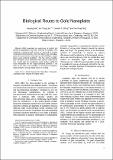| dc.contributor.author | Xie, Jianping | |
| dc.contributor.author | Lee, Jim Yang | |
| dc.contributor.author | Wang, Daniel I.C. | |
| dc.contributor.author | Ting, Yen Peng | |
| dc.date.accessioned | 2007-02-05T20:13:56Z | |
| dc.date.available | 2007-02-05T20:13:56Z | |
| dc.date.issued | 2007-01 | |
| dc.identifier.uri | http://hdl.handle.net/1721.1/35868 | |
| dc.description.abstract | Gold nanoplates are promising for optical and
electronic applications; but their synthesis is complex, often requiring a seeded growth process or spherical to triangle morphology transformation. We have discovered a biological protocol to promote the anisotropic growth of different crystal planes under ambient conditions. Thin, flat, single-crystalline gold nanoplates were produced when aqueous chloroaurate ions reacted with the mycelia-free spent medium. While the exact mechanism for this shape-controlled synthesis is not clear at this time, the possibility of achieving nanoparticle shape control in a fungal based system is exciting. | en |
| dc.description.sponsorship | Singapore-MIT Alliance (SMA) | en |
| dc.language.iso | en | en |
| dc.relation.ispartofseries | Chemical and Pharmaceutical Engineering (CPE) | en |
| dc.subject | Gold | en |
| dc.subject | Nanoparticle | en |
| dc.subject | Nanoplates | en |
| dc.subject | Triangular | en |
| dc.subject | Aspergillus Niger | en |
| dc.subject | Mycelia-Free Spent Media | en |
| dc.title | Biological Routes to Gold Nanoplates | en |
| dc.type | Article | en |
